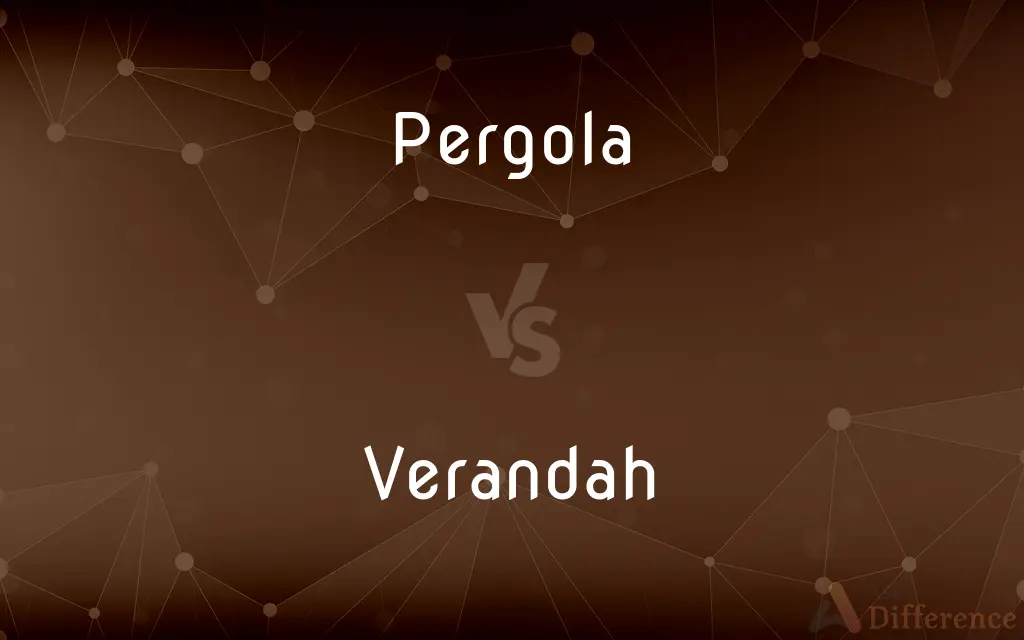Pergola vs. Verandah — What's the Difference?
By Maham Liaqat & Urooj Arif — Updated on March 8, 2024
A pergola is an outdoor garden feature forming a shaded walkway, while a verandah is a roofed platform along the outside of a house.

Difference Between Pergola and Verandah
Table of Contents
ADVERTISEMENT
Key Differences
Pergolas are distinguished by their open lattice or cross-beam structure, often supporting climbing plants, creating a natural canopy. They're typically standalone structures in gardens or extend from buildings, offering partial shade and a decorative aspect. Verandahs, on the other hand, are roofed platforms attached to the side of a house, providing a covered outdoor area that protects against the sun or rain, enhancing the living space.
Pergolas serve more as a focal point in a garden or yard, enhancing the aesthetics and providing a space for relaxation or entertainment under a semi-open roof. They can be made of various materials like wood, metal, or vinyl, and their open-top design allows for ventilation but limited protection from the elements. Verandahs are primarily functional, extending the home's living area and offering a sheltered space to enjoy the outdoors, regardless of the weather. They're usually constructed from materials that match the house, such as wood, concrete, or bricks, and are designed to blend seamlessly with the architectural style.
While pergolas are often used to define a space, create privacy, or support plants, their design does not typically offer extensive weather protection. This makes them more suited for climates where the weather is generally pleasant. Verandahs, with their solid roof structure, provide a more versatile outdoor area that can be furnished and used in various weather conditions, making them a common feature in regions with unpredictable weather.
In terms of customization, pergolas offer a range of design possibilities, from the classic wooden structure to more modern materials and styles, allowing for personalization in the garden or yard. Verandahs, while also customizable, tend to follow the architectural cues of the house, with design and material choices often aimed at complementing the existing structure and enhancing its appearance.
Pergolas and verandahs both add value to a home by increasing the usable outdoor space, but they cater to different needs and preferences. A pergola might be the choice for those looking for an elegant garden feature that supports greenery and provides a light, airy space for outdoor activities. A verandah, however, is ideal for homeowners seeking a more substantial, weather-protected area that extends the living space and offers a comfortable outdoor retreat.
ADVERTISEMENT
Comparison Chart
Structure
Open lattice or cross-beam roof
Roofed platform attached to a house
Function
Provides partial shade and supports climbing plants
Offers sheltered outdoor living space
Location
Can be standalone or attached to a building
Attached to the side of a house
Weather Protection
Limited, mainly provides shade
Provides protection from sun and rain
Material
Wood, metal, vinyl
Wood, concrete, bricks, matching house materials
Compare with Definitions
Pergola
Serves as a decorative feature and shaded area in gardens and yards.
Their new pergola became the focal point for summer gatherings, offering a cool retreat from the sun.
Verandah
Extends the living space of a house, providing a covered area for outdoor activities.
Their verandah became an additional living room, where they enjoyed evenings with family and friends.
Pergola
Characterized by its open-top structure, allowing for natural light and ventilation.
The pergola's open design allowed the breeze to flow through, making it the perfect spot for relaxation.
Verandah
A roofed, open-air gallery or porch, attached to the outside of a building.
The wide verandah wrapped around the house, offering a shaded viewpoint of the garden.
Pergola
A garden structure with an open lattice framework, often supporting climbing plants.
The pergola in the backyard, covered in climbing roses, provided a romantic setting for outdoor dinners.
Verandah
A versatile space for dining, relaxing, or entertaining, protected from the elements.
Rain or shine, their verandah was the perfect spot for the family to gather and enjoy the outdoors.
Pergola
Commonly made from wood, metal, or vinyl, depending on the desired aesthetic and durability.
They chose a wooden pergola to complement the natural landscape of their garden.
Verandah
Matches the architectural style of the house, with a focus on blending with the existing structure.
The colonial-style verandah added charm and character to their vintage home.
Pergola
Often used to define a space, create privacy, or support climbing plants and vines.
The pergola not only added beauty to their garden but also provided a private nook for quiet moments.
Verandah
Built from materials like wood, concrete, or bricks, often reflecting the construction of the house.
The stone verandah complemented the rustic look of their countryside home.
Pergola
A pergola is an outdoor garden feature forming a shaded walkway, passageway, or sitting area of vertical posts or pillars that usually support cross-beams and a sturdy open lattice, often upon which woody vines are trained. The origin of the word is the Late Latin pergula, referring to a projecting eave.
Verandah
A porch or balcony, usually roofed and often partly enclosed, extending along the outside of a building. Also called regionally gallery.
Pergola
An arbor or a passageway of columns supporting a roof of trelliswork on which climbing plants are trained to grow.
Verandah
Alternative spelling of veranda
Pergola
A framework in the form of a passageway of columns that supports a trelliswork roof; used to support and train climbing plants.
Verandah
A porch along the outside of a building (sometimes partly enclosed)
Pergola
Such a framework employed to provide shade, especially over a patio.
Pergola
Lit., an arbor or bower;
Pergola
A framework that supports climbing plants;
The arbor provided a shady resting place in the park
Common Curiosities
Can pergolas be customized?
Yes, pergolas can be customized in terms of design, material, and size to fit the aesthetics of a garden or yard.
Do pergolas offer protection from rain?
Pergolas offer limited weather protection; their open lattice roof provides shade but not significant rain coverage.
How do pergolas support plant life?
Pergolas have a lattice structure that allows climbing plants and vines to weave through and over them, creating a natural canopy.
Is a verandah considered part of the house's living space?
Yes, a verandah extends the living space of a house, offering a sheltered area for outdoor activities.
Can pergolas be attached to buildings?
Yes, pergolas can either be standalone structures in a garden or attached to a building, providing a shaded walkway or area.
What is the difference in maintenance between pergolas and verandahs?
Pergolas may require more maintenance related to the care of climbing plants, while verandahs need regular upkeep to maintain the structure and appearance.
Can a verandah be detached from the house?
No, a verandah is a roofed platform that is always attached to the side of a house.
Are pergolas suitable for all seasons?
Pergolas are more suitable for warmer seasons due to their open structure, offering limited protection in colder, wetter months.
What is the main purpose of a pergola?
A pergola primarily serves as a decorative garden feature that provides partial shade and supports climbing plants.
What materials are commonly used for verandahs?
Verandahs are typically made from materials like wood, concrete, or bricks, often chosen to match or complement the house.
How does the design of a verandah complement the house?
Verandahs are designed to match the architectural style of the house, often using similar materials and design elements to create a cohesive look.
Can pergolas have a solid roof?
Traditional pergolas have an open lattice roof, but some modern designs may incorporate a solid or partially solid roof for more shade.
Are verandahs common in all climates?
Verandahs are especially popular in climates with variable weather, as they provide a protected outdoor space.
What is the ideal location for a pergola in a garden?
The ideal location depends on the garden's layout and the homeowner's preference, but it's often placed in a spot that maximizes aesthetic appeal and usability, such as near a seating area or along a walkway.
How does a verandah enhance a home's exterior?
A verandah adds to a home's aesthetic appeal and functionality by providing an attractive, sheltered outdoor space.
Share Your Discovery

Previous Comparison
Conference vs. Meeting
Next Comparison
Chennai vs. BangaloreAuthor Spotlight
Written by
Maham LiaqatCo-written by
Urooj ArifUrooj is a skilled content writer at Ask Difference, known for her exceptional ability to simplify complex topics into engaging and informative content. With a passion for research and a flair for clear, concise writing, she consistently delivers articles that resonate with our diverse audience.














































